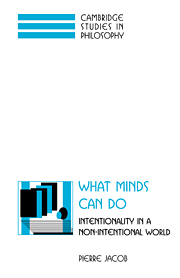Book contents
- Frontmatter
- Contents
- Acknowledgments
- Introduction
- PART I THE NATURALIZATION OF INTENTIONALITY
- PART II THE CAUSAL ROLE OF INTENTIONALITY
- 5 The computational representational theory of mind (CRTM)
- 6 Must an intentional realist be a meaning atomist?
- 7 Functionalism and the threat of preemption
- 8 Explaining intentional behavior
- 9 Conclusion: a postlude on semantics and psychology
- References
- Index
9 - Conclusion: a postlude on semantics and psychology
Published online by Cambridge University Press: 09 November 2009
- Frontmatter
- Contents
- Acknowledgments
- Introduction
- PART I THE NATURALIZATION OF INTENTIONALITY
- PART II THE CAUSAL ROLE OF INTENTIONALITY
- 5 The computational representational theory of mind (CRTM)
- 6 Must an intentional realist be a meaning atomist?
- 7 Functionalism and the threat of preemption
- 8 Explaining intentional behavior
- 9 Conclusion: a postlude on semantics and psychology
- References
- Index
Summary
As I recognized in chapter 1, the intentional realist who subscribes to token physicalism takes out, in Dennett's (1971) terms, a loan of intentionality. I have now discharged some of what I take to be the debt incurred by the intentional realist.
In part I, I have argued that semanticity has two primary nonsemantic sources: it arises out of the nomic dependencies between properties of an individual's mental states and properties instantiated in his or her environment; and it arises out of the selective processes shaping both the phylogenetic evolution of the species of which the individual is a member and the individual's ontogenetic development. My own approach to the naturalization of intentionality has, therefore, been a mixed or impure informationally based teleosemantic approach. As I remarked several times, it contrasts with both a pure teleosemantic approach and a pure informational approach.
In part II, I have tried to show that the semantic properties of an individual's propositional attitudes are causally efficacious in the production of his or her intentional voluntary behavior. In fact, I have argued that not only do the semantic properties of an individual's beliefs contribute to the explanation of his or her intentional voluntary behavior, but also that the semantic properties of an individual's innate representations explain his or her intentional non-voluntary behavior. In arguing this, I have borrowed two ideas from Dretske (1988): one is the componential conception of behavior; the other is the idea that semantic properties of an individual's representations explain his or her behavior in a causal structuring sense.
- Type
- Chapter
- Information
- What Minds Can DoIntentionality in a Non-Intentional World, pp. 270 - 280Publisher: Cambridge University PressPrint publication year: 1997



